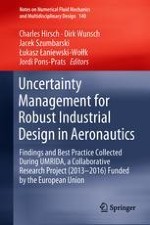This book covers cutting-edge findings related to uncertainty quantification and optimization under uncertainties (i.e. robust and reliable optimization), with a special emphasis on aeronautics and turbomachinery, although not limited to these fields. It describes new methods for uncertainty quantification, such as non-intrusive polynomial chaos, collocation methods, perturbation methods, as well as adjoint based and multi-level Monte Carlo methods. It includes methods for characterization of most influential uncertainties, as well as formulations for robust and reliable design optimization. A distinctive element of the book is the unique collection of test cases with prescribed uncertainties, which are representative of the current engineering practice of the industrial consortium partners involved in UMRIDA, a level 1 collaborative project within the European Commission's Seventh Framework Programme (FP7). All developed methods are benchmarked against these industrial challenges. Moreover, the book includes a section dedicated to Best Practice Guidelines for uncertainty quantification and robust design optimization, summarizing the findings obtained by the consortium members within the UMRIDA project. All in all, the book offers a authoritative guide to cutting-edge methodologies for uncertainty management in engineering design, covers a wide range of applications and discusses new ideas for future research and interdisciplinary collaborations.
